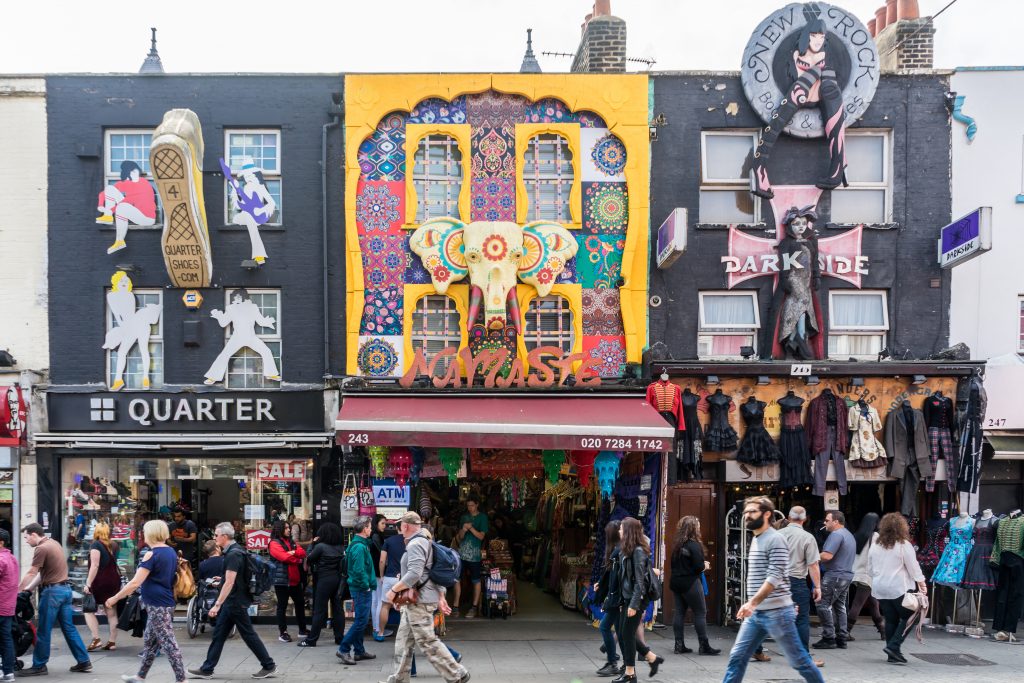Matthew Knowles
Trading Standards Consultant
Camden Town has a rich history in commerce and trade and was once known as London’s main transport terminus for goods traffic and internationally renowned gin distilleries. It is now home to one of the most famous markets in the world, which supports a surrounding industry of souvenir, apparel and accessory shops. Although the area is known for its vibrancy and independent spirit, it has suffered from a negative reputation due to the sale of counterfeit goods from a minority but significant number of traders. The bulk of counterfeit goods are sold on the High Street between Camden tube station and Regents Canal, predominantly from souvenir style shops. The souvenir industry which occupies some of London’s most expensive retail outlets is allegedly run by Afghan networks linked to tax fraud and money laundering (Private Eye News 2019). This reflects the growing awareness that Intellectual Property crime is interconnected with other types of serious crimes (Europol/EUIPO 2020).
ONE COUNTERFEITER’S STORY
Commonly, the shops are divided by wall space or tables and sublet to different traders informally. AB (name changed for the purpose of this article) came to the UK in 2003 from Afghanistan and started trading in counterfeit goods in 2007. He started working for someone else before buying his own stock to sell. “I rented a wall for between £1700- £2200 per week. Two other traders rented space and paid it to the main guy who informally rented the shop from the landlord for around £5000 per week in cash.”
AB said the main attraction of selling counterfeit goods was because they were so easy to get and required very little upfront capital. “If the wholesaler knew you or someone you were connected to, he would give you goods on credit and come and collect his repayments on a weekly basis. If Trading Standards seized your goods you would show the wholesaler the paperwork as proof, and he would replace the stock for free. This is less common now as too many people were disappearing with the goods and not paying.”

AB said over the years wholesale prices for counterfeit goods have decreased but the variety and ranges in quality have increased. “You can choose from ‘A’ to ‘triple A’ categories, and with some goods such as watches these categories are broken down into further categories of quality.”
AB says most goods originally come from China and Turkey and are often supplied via wholesalers in London, Manchester or Birmingham or imported directly by some traders in smaller consignments.
He states, “the most profitable items are watches then belts and bags. A good counterfeit watch purchased at wholesale for around £15 can be sold for between £150- £300. For some luxury bags, it is cheaper for us to buy the bags and badges (trademark and logos) separately and make them ourselves, for example wholesale price is around £26 with a badge already attached, instead of £6 per bag plus £1 per badge.”
Monthly multi-agency raids including Trading Standards, Police, Immigration Enforcement and Anti-Counterfeiting Group (ACG) brand protection professionals have resulted in the seizure of hundreds of thousands of pounds worth of counterfeit stock but the problem still persists. This is largely down to the lack of resources for law enforcement agencies to prosecute all offenders and delve deeper into wholesale supply and proceeds of crime.
Graham Mogg, Intelligence Coordinator at the Anti-Counterfeit Group (ACG) comments that “a multi-agency partnership approach is the only way to tackle this level of counterfeiting activity. Over the last 6 years we have developed a joint program with Camden Trading Standards, sharing brand intelligence and coordinating brand resources to strengthen the enforcement response.”
Between May 2019 and March 2020 Trading Standards and the ACG led a refreshed campaign to target supply and undertake a broader investigation into problem. Mobile purchase hardware equipment such as Process Data Quickly (PDQ) machines were traced, landlords and leaseholders were identified, financial intelligence was gathered, suspects were interviewed and considered for prosecution, and wholesale storage was targeted. This had a positive impact and certainly reduced the visibility of counterfeit goods. However this focus could not be sustained due to a reduction in resource and competing priorities.
AB thinks the best way to reduce the problem is to target the source, namely the wholesalers and also the parcel delivery companies who enable delivery of counterfeit goods to distributors in the area. Additionally he believes the end users of “PDQ” machines should be identified where possible to identify the actual beneficiaries as opposed to the sellers who in some cases are at the bottom of the hierarchy and are getting paid a small daily rate in cash.
Despite the growth in online sales of counterfeit goods, physical market spaces continue to pose significant challenges for brand holders and law enforcement agencies in the UK. A collaborative, targeted and prolonged approach is needed which analyses consumer attitudes and behaviors so demand can be reduced, alongside a deeper investigation into supply routes and enablers enforcement action can be taken against the most serious offenders.
THE BRAND PROTECTION PROFESSIONAL | SEPTEMBER 2020 | VOLUME 5 NUMBER 3
COPYRIGHT 2020 MICHIGAN STATE UNIVERSITY BOARD OF TRUSTEES
